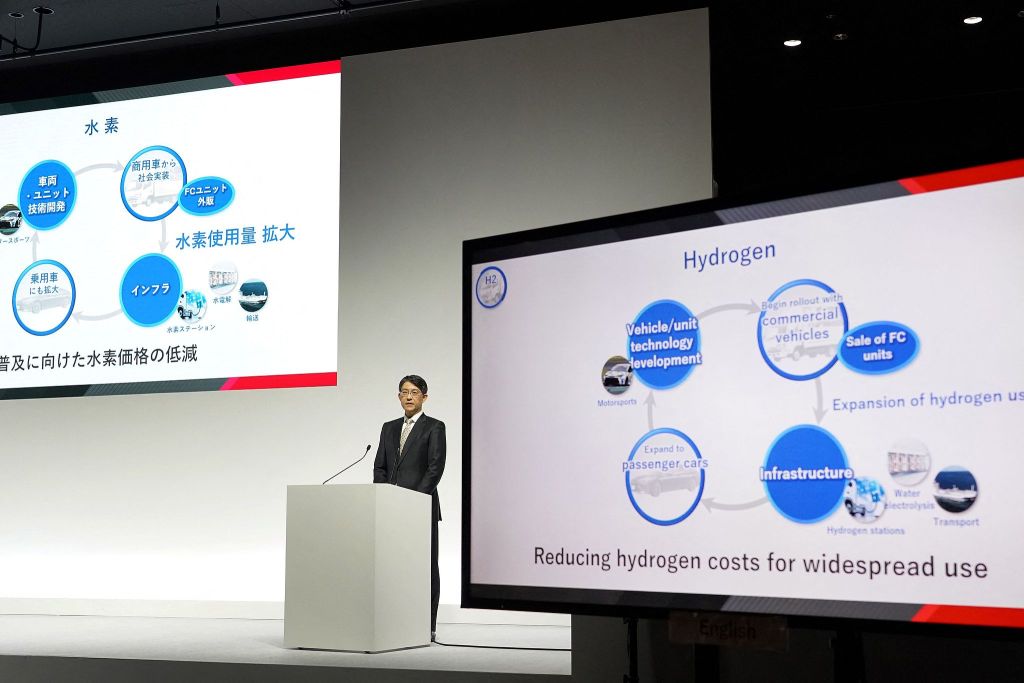
Tranalysis
Under the dual pressures of the tariff stick wielded by the Trump administration and the appreciation of the yen, Toyota Motor Corporation is expected to see a sharp 34.9% year-on-year decline in net profit for the fiscal year 2026 (from April 1, 2025, to March 31, 2026), amounting to 3.1 trillion yen. If the expectation materializes, this figure will not only set the record for its largest decline in nearly a decade but also reflect the survival predicament of traditional manufacturing giants amidst the retreat of globalization.
As the world's largest automobile manufacturer, Toyota's profit warning serves as a prism for the industry, projecting the multiple contradictions of trade protectionism, technological route divergence, and industrial structure reconstruction in front of every practitioner.

On May 8, 2025, local time, in Tokyo, Japan, Toyota Motor Corporation CEO Koji Sato spoke at the company's financial results press conference.
The 25% tariff on cars and auto parts implemented by the Trump administration since April 2025 has precisely targeted the globalized production models of automakers, including Toyota. Among the 530,000 cars exported from Japan to the United States each year, the high-profit Lexus accounts for 20%, and each imported car will incur an additional $3,200 in tariff costs, far exceeding the average profit margin of compact SUVs.
Although Toyota has preliminarily accounted for the tariff losses of 180 billion yen in April-May 2025, its \3 million production system\ that relies on 60,000 domestic suppliers in Japan is at risk. And even if Toyota wants to \accommodate\ Trump's wishes to produce locally in the United States, considering the complexity of craftsmanship for high-premium models such as Lexus, as well as the \loose\ working style of American production workers, it may be difficult to localize quickly. Therefore, in the short term, its tariff costs can only be internally absorbed, which may directly lead to a sharp drop in the operating profit margin in the North American market from 12% in 2024 to 0.6%.
The appreciation of the Japanese yen against the US dollar further exacerbated Toyota's financial difficulties. In 2024, the yen appreciated by 18%, reducing the operating profit of North American operations by $1.2 billion, and it is expected that the depreciation of the dollar in the fiscal year of 2026 will further erode profits by 74.5 billion yen. This \scissors gap\ effect of monetary policy has increasingly narrowed Toyota's room for error in its exchange rate hedging strategy.
On the other hand, although Toyota's hybrid models still contribute 42% of global sales, pure electric models only account for 2% of the share. The Trump administration's policy of imposing a 10% tariff on Chinese-made battery components has forced Toyota's business in the U.S. market to accelerate decoupling from Chinese suppliers. In the Chinese market, under the acceleration of localization strategy, the new generation of bZ series products - Plati3X, Plati7, bZ5 and other new models have made significant progress in intelligence and cost control, but in the short term, they are still difficult to face cost monsters like BYD.
To avoid tariffs, Toyota is expanding its Kentucky plant in the United States with an investment of $1.2 billion, planning to increase the concentration of RAV4 production capacity in North America from 40% to 80%, and to promote the localization rate of parts from 40% to 60%. This \regional closed-loop\ strategy can save $1,700 per vehicle, but it requires an increase in fixed costs of $1,500 per unit, and core components such as hybrid control units still rely on the Denso factory in Japan. Obviously, in-depth adjustments to the industrial chain can never be achieved overnight.
Trump's recent exemption from steel and aluminum tariffs and the policy of allowing a 3.75% tariff compensation have provided Toyota with some breathing space. However, the construction of its North American battery factory depends on the maturity of the domestic supply chain in the United States, and the current U.S. battery production capacity can only meet one-third of the demand. The shortage of skilled workers and lagging infrastructure may hinder the transition process.
Toyota's profit warning is a microcosm of the automotive industry in the \post-globalization era.\ When tariff barriers replace free trade agreements, and regional production replaces global division of labor, traditional giants are forced to make a new choice between efficiency and safety. Data shows that among the 5.9 million cars sold by Japanese automakers in the United States, about half rely on imports, and this structural vulnerability is becoming more pronounced in the political cycle.
As Trump said, \We buy millions of cars from Japan every year, while Japan only buys a few hundred cars from us.\ The policy orientation of the Trump administration's \Made in America\ requirements is pushing the automotive industry from \cost priority\ to \geographical priority,\ forcing companies to prioritize supply chain security over profit maximization.
As the world's leading automaker in both sales and profits, Toyota's predicament and breakthrough have industry benchmark significance. If it can complete the reorganization of production capacity in North America and the mass production of solid-state batteries before 2027, it may be able to achieve a soft landing with the technological moat of hybrid power and the new generation of pure electric vehicle models; on the contrary, if it continues to be entangled in the controversy over technological routes and the uncertainty of geopolitical games, its global hegemonic position will face challenges as profit margins continue to shrink.
